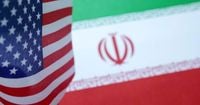In a move that has stunned many observers and reignited debate over U.S. immigration policy, the Trump administration has deported around 100 Iranians from the United States to Iran, marking one of the largest such operations in years. The flight, chartered by the U.S. government, departed from Louisiana late Monday, September 29, 2025, and was scheduled to arrive in Iran via Qatar on Tuesday, September 30, 2025, according to reporting by The New York Times and corroborated by Iranian officials.
This deportation is not just a matter of numbers. It represents a rare moment of cooperation between two governments that have often found themselves at odds on the global stage. Months of negotiations between Washington and Tehran led up to the flight, with both sides working out the complex logistics of returning such a large group of people to a country with which the United States has had limited diplomatic relations for decades.
Iranian officials, including Hossein Noushabadi, the foreign ministry's director general for parliament affairs, confirmed the details to the semi-official Tasnim news agency, stating, "One hundred and twenty people should be deported and flown home over the next couple of days." He added, "The U.S. immigration service has decided to deport around 400 Iranians currently in the United States, most of them after entering illegally." While the current flight carried around 100 to 120 individuals, it is reportedly the first step in a larger plan to deport up to 400 Iranians, most of whom entered the U.S. through Mexico or without legal status.
For decades, the United States has been a destination for Iranians fleeing political repression, religious persecution, or seeking better opportunities. Iran is notorious for its harsh human rights record, with activists, journalists, religious minorities, and members of the L.G.B.T.Q. community often facing severe consequences. As The New York Times noted, the U.S. has typically hesitated to deport migrants to countries like Iran, both for humanitarian reasons and because of the logistical challenges posed by the lack of diplomatic ties and travel documents. This time, however, the Trump administration pressed forward, citing a need to address what it described as high illegal border crossings under the previous Biden administration.
Some of the deportees volunteered to leave after months in U.S. detention centers, while others did not go willingly. Iranian officials told The New York Times that the group included men, women, and couples. In nearly every case, asylum requests had been denied or the individuals had not yet appeared before a judge for an asylum hearing. There were also reports that some of the deportees had residence permits but were nonetheless included in the deportation list, with their consent obtained for their return, according to Noushabadi.
The identities of those on the flight and their specific reasons for seeking refuge in the United States remain unclear. What is known is that many Iranians arriving at the southern U.S. border in recent years have claimed fear of persecution back home, whether for political, religious, or other personal reasons. Earlier in 2025, the United States deported groups of Iranians—many of them converts to Christianity who claimed they would face persecution if returned to Iran—to third countries such as Panama and Costa Rica. Those cases sparked lawsuits from immigrant advocates, who argued that such deportations violated the migrants' rights and put them at risk.
The current deportation is notable not only for its scale but also for its timing. Iran is in the midst of a severe economic and energy crisis, with its currency plunging, inflation soaring, unemployment high, and recurring water and power shortages. The situation is expected to worsen with the recent reimposition of United Nations Security Council sanctions, which went into effect on Saturday, September 27, 2025. According to The New York Times, these sanctions are likely to deepen the hardships faced by ordinary Iranians, including those now being returned from the United States.
Iran's Foreign Ministry has coordinated the return of the deportees and, according to Iranian officials, provided assurances that they would be safe and would not face any problems upon arrival. One Iranian official told The New York Times, "Many of the migrants are still disappointed, and some are even afraid." Despite these reassurances, the prospect of returning to a country with a record of political oppression and economic instability has left many deportees anxious about their future.
The Trump administration has made no secret of its intent to carry out the largest mass deportation of undocumented immigrants in U.S. history. This latest operation is part of a broader crackdown on illegal immigration, which the administration argues is necessary to restore order at the border and uphold the rule of law. According to Reuters, the White House and U.S. State Department did not immediately respond to requests for comment on the deportation operation. The administration has struggled, however, to significantly increase overall deportation levels, even as it has created new avenues to send migrants to countries other than their own.
In February 2025, for example, the United States deported 119 people from various countries, including Iran, to Panama as part of bilateral agreements. Many of those deportations involved individuals who had not been able to secure protection in the United States and were sent to third countries. These efforts have not been without controversy, as legal challenges continue to surface over the rights of migrants and the potential dangers they face upon return to their countries of origin.
The deportation of Iranians from the United States is, in many ways, a microcosm of the larger debates and dilemmas facing immigration policy today. On one hand, the Trump administration frames its actions as a necessary response to illegal entry and the need to enforce immigration laws. On the other, critics argue that deporting vulnerable individuals—some of whom may face persecution or hardship—runs counter to the United States' long-standing tradition of offering refuge to those in need.
For now, the fate of the deported Iranians hangs in the balance. As they touch down in a country grappling with its own crises—political, economic, and social—their stories serve as a stark reminder of the human cost of international politics and policy decisions. The rare cooperation between the U.S. and Iran in this instance may be seen as a diplomatic breakthrough by some, but for those on the receiving end, it is a moment fraught with uncertainty and fear.
As the world watches how these individuals are treated upon their return and whether the promised assurances of safety hold true, the broader questions about migration, human rights, and international responsibility remain as pressing as ever.





